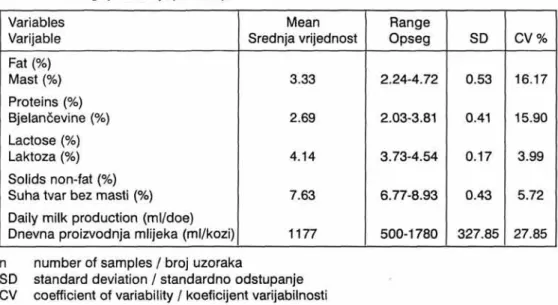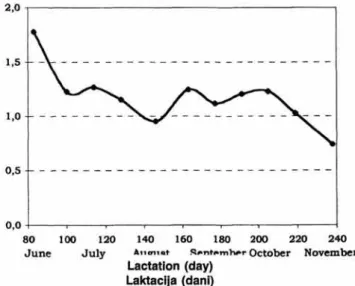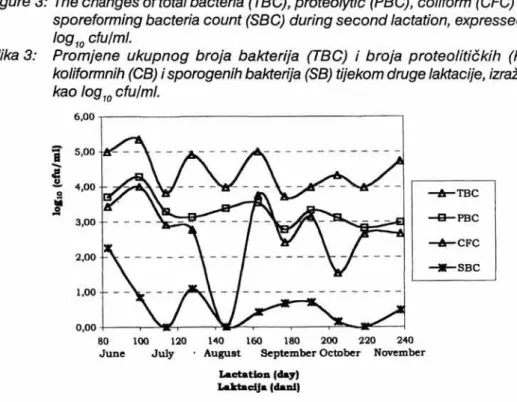The changes of microbiological and chemical composition of
goat's milk during second lactation
Andreja Miklič-Anderlič, Irena Rogelj
Original scientific paper - Izvorni znanstveni rad UDC: 637.12'639 Summary
Individual milk samples from the evening and morning milking, of 10 Alpine goats, were taken twice a month from June to November 1999. The goats were in
the third month of lactation. 200 milk samples were analysed for standard plate count, conforms, proteolytic bacteria, sporeforms and chemical composition. Milk production was followed individually for each goat. Milk contained on average
5,65-10^ cfu/ml of total count, 2,04-10^ cfu/ml of coliforms, 3,57-10^ cfulml of pro teolytic bacteria and 20 cfulml of sporeforms. Daily milk production decreased during the first month of milking (the third month of lactation) and then remained constant. The average milk production was 1177 ml I doe I day. Concentration of all measured milk components (fat, total protein, solids non-fat and total solids), with the exception of lactose, increased slightly. Overall mean of chemical composition was 3.33 % fat, 2.69 % total proteins, 4.14 % lactose, 7.63 % solids non-fat and 10.96 % total solids.
Key words: goat's milk, milk composition, standard plate count, milk pro duction.
Introduction
The production of the small ruminants milk has been increasing all over the world although at a lower rate than production of cow's milk. In Slovenia, goat's milk is produced by the two breads, Saanen and Alpine, that are included into the national breeding programme.
The composition and the quality of milk are very important, being a raw material for the production of the delicious products. Many factors influence the quality, composition and characteristics of the milk. These factors could be grouped as genetic (among different breeds, flocks and individuals), physiologi cal (period of lactation, age, state of health) and environmental (nutrition, cli matic conditions, season, the methods of milking, management with the ani mal). The composition of the milk determines its nutritional value, quality and suitabihty for the production of dairy milk products ( R o g e l j , 1996).
In Slovenia, all registered goat breeders are included in the programme called Origin and production control. Control of milk is going on in accordance with ICAR standard reference method A4: once a month a chemical
composi-tion of milk samples and milkiness is determined during the lactacomposi-tion period. The microbiological quality control of milk during the lactation period is not included in this programme.
The average composition of milk of Alpine breeds in Slovenia is 3.1 % fat, 2.8 % proteins, 4.2 % lactose and 10.8 % total soHds ( K o m p a n et al., 1999; K o m p r e j et al., 2000).
As some breeders process milk at home, mostly into the cheese, the aim of our study was to determine the changing of microbiological and chemical com position of milk during lactation. The results of this study will help the breeders to optimise goat's milk processing and to achieve a high quahty of the products during the entire production period.
Materials and Methods
Experimental animals:
Ten healthy milking does in their second lactation were randomly selected from the Alpine herd. The does were fed with a high grain and low fibre ratio during milking supplemented with hay, by night, and pasturage in the daytime. All experimental does were kidded in the early March and dried off in mid-November 1999.
Sample collection:
First sampling was made 3 weeks after the first milking (3 months after parturition). Individual milk samples of evening and morning milking proce dures were collected twice a month till the end of lactation (June to November). Before sampling, the volume of milk from each goat was measured. 200 goat's milk samples were collected. Composite samples, made of equal volumes of evening and morning milk, were prepared for microbiological analysis.
Sample analyses:
Total bacteria counts (TEC) and coliforms (CFC) were determined ac cording to standard plate count method (IDF 100B:1991; IDF 73A:1985). For the determination of proteolytic bacteria count (PBC) and sporeforming bacte ria count (SBC), the methods described in Methodenbuch (Band VI, M7.3.3; M7.17.2) were used. The results were expressed as log^^ of colony forming units in ml (log^Q(cfu/ml)). Milk components (fat, protein, lactose, solids-non-fat (SNF) and total solids (TS) were analysed by Milko-Scan 133B (Foss Electric).
Statistical analysis:
The obtained goat's milk data were analysed using Microsoft Excel pro gram. Mean, standard deviation (SD) range and coefficient of variability were calculated.
Results and Discussion
The basic statistics of all tested variables of goat's milk samples collected
during five months of lactation are summarised in Tables 1 and 2.
Table 1: Chemical composition of goat's milk and daily milk production (ml/doe) in second lactation (n=200).
Tablica 1: Kemijski sastav kozjeg mlijeka i dnevna proizvodnja mlijeka (ml/kozi) u drugoj laktaciji (n=200). Variables Varijable Mean Srednja vrijednost Range Opseg SD CV% Fat (%) Mast (%) 3.33 2.24-4.72 0.53 16.17 Proteins (%) Bjelančevine (%) 2.69 2.03-3.81 0.41 15.90 Lactose (%) Laktoza (%) 4.14 3.73-4.54 0.17 3.99 Solids non-fat (%)
Suha tvar bez masti (%) 7.63 6.77-8.93 0.43 5.72 Daily milk production (ml/doe)
Dnevna proizvodnja mlijeka (ml/kozi) 1177 500-1780 327.85 27.85 n number of samples / broj uzoraka
SD standard deviation / standardno odstupanje CV coefficient of variability / koeficijent varijabilnosti
Table 2: Microbiological composition of goat's milk for 10 Alpina goat's in second lactation (n=100).
Tablica 2: Mikrobiološki sastav kozjeg mlijeka od 10 Alpina koza u drugoj laktaciji (n=100). Variables Varijable Mean Srednja vrijednost Range Opseg SD CV% Total bacteria counts (log,o(cfu/ml))
Mezofilne aerobne bakterije (log,(j(cfu/ml)) 4.75 3.40-5.49 0.61 12.86 Coliforms (log,o(cfu/ml))
Koliformne bakterije (log^Q(cfu/ml)) 3.31 0.00-4.26 1.16 35.15 Proteolyts (log,o(cfu/ml))
Proteolitičke bakterije (log,o(cfu/ml)) 3.55 0.00-4.64 0.60 16.78 Sporeforms (log,Q(cfu/ml))
Spore (log^Q(cfu/ml)) 1.30 0.00-2.92 0.64 48.85 n number of samples / broj uzoraka
SD standard deviation / standardno odstupanje CV coefficient of variability / koeficijent varijabilnosti
The Alpine goat's milk, analysed in our experiment contained on average 3.33 % of fat (Table 1), which agreed with the values reported by Z e n g and E s c o b a r (1996a), but was lower than the values for Alpine goat's in Greece (3.44 %) reported by V o u t s i n i a s et al. (1990) and Alpine goat's in USA (3.73 and 3.94%) reported by Z e n g and E s c o b a r (1995,1996b) and P a r k (1991). C a l a m a r i et al. (1990), J a u b e r t (1996), P a s q u i n i et al. (1996), Rogelj et al. (1998) and Z e n g et al. (1997) reported lower fat values for the same breeds. At the end of the third month of the lactation, milk contained 3.01 % of fat. During lactation two rises were observed. First in the beginning of the fifth month of lactation and the second at the end of lactation when the highest con tent of fat (4.01 %) was determined (Figure 1).
Protein content of milk increased progressively with advancing lactation (Figure 1). A similar trend was observed by V o u t s i n i a s et al. (1990). Other workers reported that protein concentration decreased during the first four months of lactation, and then increased till the end of lactation (Zeng and E s c o b a r , 1995; 1996a; 1996b, D a n k o w et al., 1996). In this experiment the milk samples during the first two months of lactation were not taken as the producer started with milking after this period of sucking. The average protein content was higher than the value reported by C a l a m a r i et al. (1990), but lower than the value reported by the other authors ( Z e n g et al. 1997, 1996a, Figure 1: Chemical composition of goat's milk during second lactation: percentage
of fat (7o F), protein (% P), lactose (% L), total solids (% TS) and solids non fat (% SNF).
Slika 1: Kemijski sastav kozjeg mlijeka tijekom druge laktacije: postotak mliječne masti (% F), bjelančevina (% P), laktoze (% L), suhe tvari (% TS) i suhe tvari bez masti (% SNF). % - % F - % P • % L - % S N F • % T S 80 100 120 140 160 180 2 0 0 220 240
June July August September October November Lacstatlon (day)
1996b; Jaubert et al. 1996; Park 1991; Pasquini et al. 1996; Pizzillo et al.
1996; Voutsinias et al. 1990 and Zeng and Escobar 1995. The initial pro
tein content in the fourth month of lactation was 2.37 %. During the following
period, protein content increased up to 3.51 % in the last sample. From the
technological point of view (milk is designed for cheese production) the protein
content was absolutely too low till the seventh month of lactation. Low protein
content in goat's milk was highly effected by genetic factors, while unbalanced
nutrition was responsible as well.
Lactose content was relatively constant throughout the lactation (Figure
1). The average value of lactose was 4.14 %, which agrees with the values re
ported byZeng etal. (1997). It was lower than the values reported by J aubert
et al. (1996), Voutsinias et al. (1990), by Pasquini et al. (1996), Rogelj et
al. (1998) and Zeng and Escobar (1995, 1996a, 1996b); and higher than the
values reported by Calamari et al. (1990).
The solids non-fat and total solids content increased throughout lactation
(Figure 1). The average SNF and TS content was 7.63 % and 10.96 %, respec
tively. The same value for TS content was observed by Calamari et al. (1990).
The values reported by other authors are lower (Rogelj et al., 1998; Zeng et
al., 1997) or higher (Pizzillo et al. 1996; Voutsinias et al. 1990; Zeng and
Escobar, 1995,1996a, 1996b).
The overall milk production during lactation is illustrated in Figure 2. Daily
milk production was high at the end of the third month of lactation (1780 ml/
doe) and during the forth month decreased to the value of 1227 ml/doe. Milk
Figure 2: Average daily milk production per doe during sampling period.Slika 2: Prosječna dnevna proizvodnja mlijeka po kozi tjekom uzimanja uzoraka.
J!
80 100 120 140 160 180 200 220 240 June July Aumiat R»«nti»Tnb^r Octobcr Novcmbcr
Lactation (day) Laktacija (dani)
Figure 3: The changes of total bacteria (TBC), proteolytic (PBC), coliform (CFC) and sporeforming bacteria count (SBC) during second lactation, expressed as log ^^ cfu/ml.
Slika 3: Promjene ukupnog broja bakterija (TBC) i broja proteolitičkih (PB), koliformnih (CB) isporogenih bakterija (SB) tijekom druge laktacije, izražene kao log^^ cfu/ml.
6,00 0,00 80 100 120 140 160 180 200 220 240 J u n e J u l y • A u g u s t S e p t e m b e r O c t o b e r November Lactation (day) Laktacija (dani)
production between the fourth and seventh month of lactation remained con
stant (on average 1200 ml/doe per day) and afterwards started to decrease con
tinuously till the end of lactation. In August, milk production was only 955 ml/
doe per day. That was probably due to weather conditions. The mean daily milk
production during 5.5 months of lactation (from the end of the third month till
the end of lactation) was 1177 ml.
Total bacteria count, as well as proteolytic, coliforms and sporeforming
bacteria in goat's milk are shown in Table 2 and Figure 3. TBC of goat's milk
was under the permited regulation level of 1.0x10^ cfu/ml throughout the lacta
tion. The total bacteria count as well as the counts of all other determined groups
of bacteria slowly decreased during the lactation. This was probably due to in
creased hygienic conditions of milking caused by our regular control.
Conclusions
The results of the analysis show that the concentration of milk compo
nents change markedly during lactation. The concentration of fat, protein, sol
ids non-fat and total solids increased from the third month of lactation till the
end of lactation. From the technological point of view the chemical composition
of goat's milk was poor till the sixth month of lactation. Such variability of milk
composition makes impossible standard quality cheese production without
tech-nological process improvements. Besides, the change of the kidding system will
be indispensable. The microbiological quality of milk was good. The slight re
duction of bacterial count during lactation was probably caused by our regular
control.
PROMJENE MIKROBIOLOŠKOG I KEMIJSKOG SASTAVA KOZJEG
MLIJEKA TIJEKOM DRUGE LAKTACIJE
Sažetak
Dva puta mjesečno, od lipnja do studenoga 1999 (tri tjedna nakon prve
mužnje), su oduzimani pojedinačni uzorci večernjeg i jutarnjeg mlijeka od 10 koza
smaste pasmine. U 200 uzoraka mlijeka analiziran je ukupan broj mezofilnih,
koliformnih i proteolitičkih bakterija te spora, i kernijski sastav mlijeka. Kod
pojedinačne koze praćena je i proizvodnja mlijeka, odnosno mliječnost. Mlijeko je
u prosjeku sadržavalo 5,65'10"* mezofilnih aerobnih bakterija/ml, 2,04-10"^
koliformnih bakterija/ml, 3,57-10^ proteolitičkih bakterija/ml i 20 spora/ml.
Proizvodnja mlijeka smanjila se je u prvom mjesecu mužnje, da bi nakon toga
ostala nepromjenjena. Prosječna dnevna proizvodnja mlijeka je bila 1177 ml/kozi.
Koncentracija svih analiziranih sastojaka mlijeka (mliječna mast, bjelančevine,
suha tvar bez masti i suha tvar) s izuzetkom laktoze, lagano se povećavala. Mlijeko
je u prosjeku sadržavalo 3,33 % masti, 2,69 % bjelančevina, 4,14 % laktoze, 7,63
% suhe tvari bez masti i 10,96% suhe tvari.
Ključne riječi: kozje mlijeko, sastav mlijeka, ukupni broj mezofilnih bakterija,
proizvodnja mlijeka.
References
CALAMARI, L., MAIANTI, M.G., CAPPA, V, VECCHIOTTI, G.G. (1990): Profilo metabolico di capre Saanen durante la lattazione. In: Annali della Facolta diAgraria, 2, 151-163. DANKÖW, R., WÖJTOWSKI, J., WOJCIECHOWSKI, J., MATYLLA, P, MALINOWSKI, E.
(1996): Somatic cell and physico-chemical traits of milk of Polish white improved goat. In: Rubino, R. (ed.). Somatic cells and milk of small ruminants: Proceedings of the Sympo sium on Somatic cells and milk of small ruminants, Bella, Italy, 25-27 September 1993, (EAAP publication, No. 77). Wageningen: Wageningen Pers, 1996, 295-300.
IDF 100B:1991: Milk and milk products: Enumeration of microorganisms: Colony count tech nique at 30 °C. International Dairy Federation.
IDF 73A:1985: Milk and milk products: Enumeration of coliforms: Colony count technique and most probable number technique at 30 °C. International Dairy Federation.
JAUBERT, G., GAY-JACQUIN, M.F., P E R R I N , G. (1996): Numerations cellulaires et caracteristiques biochimiques et technologiques du lait de chčvre. In: Rubino, R. (ed.). Somatic cells and milk of small ruminants: Proceedings of the Symposium on Somatic cells and milk of small ruminants, Bella, Italy, 25-27 September 1993, (EAAP publication. No. 77). Wageningen: Wageningen Pers, 1996, 263-268.
KOMPAN, D., DROBNIC, M., KOMPREJ, A., BIRTIC, D. (1999): Rezultati mlečnosti koz in • ovc V letu 1998. Drobnica, 4, 10-12.
KOMPREJ, A., CIVIDINI, A., DROBNIĆ, M., KOMPAN, D. (2000): Mlečnost koz v kontroliranih tropih v Sloveniji v letu 1999. Univerza v Ljubljani, Biotehniška fakulteta, Oddelek za zootehniko.
METHODENBUCH BAND VI, M7.3.3: Bestimmung von Eiweißzersetzern (Proteolyten): Verfahren mit Milchagar. In: Methodenbuch, Band VI, Chemische, physikalische und microbiologische, Untersuchungsverfahren fur Milch, Milkcprodukte und Molkereihilfsstoffe 1993, VDLUFA-Verlag, Darmstadt.
METHODENBUCH BAND VI M7.17.2: Bestimmung der Sporen aerober Sporenbildner (Bacillus)In: Methodenbuch, Band VI, Chemische, physikahsche und microbiologische, Untersuchungsverfahren fur Milch, Milkcprodukte und Molkereihilfsstoffe 1985, VDLUFA-Verlag, Darmstadt.
PARK, Y.W. (1991): Interrelationships between somatic cell counts, electrical conductivity, bac teria counts, percent fat and protein in goat milk. Small Ruminant Res., 5, 367-375. PASQUINI, M., BALLOU, L.U., BREMEL, R.D., GREPPI, G.F (1996): Detection of pro
teolytic degradation of milk proteins and relationship with different levels of SCC in Ital ian Goats. In: Rubino, R. (ed.). Somatic cells and milk of small ruminants: Proceedings of the Symposium on Somatic cells and milk of small ruminants, Bella, Italy, 25-27 Septem ber 1993, (EAAP publication. No. 77). Wageningen: Wageningen Pers, 1996, 275-281. PIZZILLO, M., COGLIANDRO, E., RUBINO, R., FEDELE, V (1996): Relationship between
somatic cells and milk quahty in different goat production systems. In: Rubino, R. (ed.). Somatic cells and milk of small ruminants: Proceedings of the Symposium on Somatic cells and milk of small ruminants, Bella, Italy, 25-27 September 1993, (EAAP publication. No. 77). Wageningen: Wageningen Pers, 1996, 269-273.
ROGELJ, I. (1996): Lastnosti in sestava ovčjega in kozjega mleka. Drobnica, 2, 3-5.
ROGEU, I., PERKO, B., KOVAČ, M. (1998): Coagulation properties of goat milk in the first three months of lactation. In: Flamant, J.C, Gabiha, D, Espejo Diaz, M. (ed.). Basis of the quality of typical Mediterranean animal products: Proceedings of the International Sym posium on Basis of the quality of typical Mediterranean animal products, Badajoz and Zafra, Spain, 29 September - 2 October 1996, (EAAP publication. No. 90). Wageningen: Wageningen Pers, 1998, 256-261.
VOUTSINAS, L., PAPPAS, C, KATSIARI, M. (1990): The composition of Alpine goat's milk during lastation in Greece. J. Dairy Res., 57, 41-51.
ZENG, S.S., ESCOBAR, E.N. (1995): Effects of parity and milk production on somatic cell count, standard plate count and composition of goat milk. Small Ruminant Res., 17, 269-274.
ZENG, S.S., ESCOBAR, E.N. (1996a): Effects of breeds and milking method on somatic cell count, standard plate count and composition of goat milk. Small Ruminant Res., 19, 169-175.
ZENG, S.S., ESCOBAR, E.N. (1996b): Factors affecting somatic cell counts of goat milk through out lactation: parity and milk production. In: Rubino, R. (ed.). Somatic cells and milk of small ruminants: Proceedings of the Symposium on Somatic cells and milk of small rumi nants, Bella, Italy, 25-27 September 1993, (EAAP publication. No. 77). Wageningen: Wageningen Pers, 1996, 157-165.
ZENG, S.S., ESCOBAR, E.N., POPHAM, T. (1997): Daily variations in somatic cell count, com position, and production of Alpine goat milk. Small Ruminant Res., 26, 253-260.
Author's addresses - Adresa autora: Received - Prispjelo: April 3, 2000
M. Sc. Andreja Miklič-Anderlič Accepted - Prihvaćeno: May 25, 2000 Prof. Ph. D. Irena Rogelj


